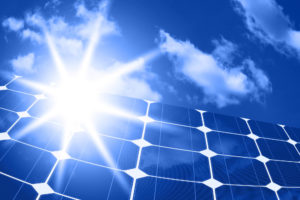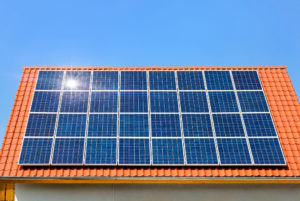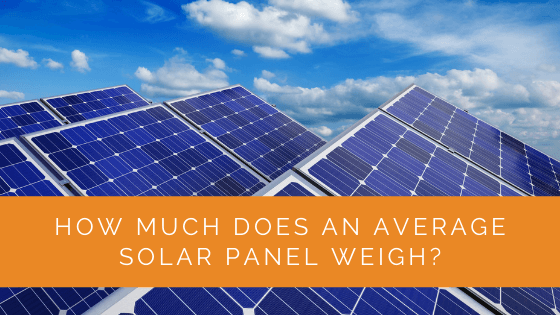Solar panels are becoming increasingly common by the day, and justifiably so. Solar power in the US offsets more than 70 million metric tons of carbon dioxide annually, almost the same as planting 1.2 billion trees!
When we talk about weights and sizes, there isn’t too much variation across different solar panels. However, a lot depends on the technology, materials, and manufacturer.
Since solar panels are an investment for decades, it is crucial that we understand their standard weights, the different factors affecting them, and the impact of their weight on rooftops.
Let’s get straight to it then, shall we?
Contents
- 1 Key Takeaways
- 2 How Much Do Solar Panels Weigh?
- 3 What Makes a Solar Panel Heavy?
- 4 Types of Panel
- 5 Solar Panel Weight Comparison
- 6 Is Your Roof Capable of Supporting a Solar Panel?
- 7 How to Determine the Strength of a Roof?
- 8 Can the Solar Panels Damage Your Roof?
- 9 Are Solar Panel Weights Likely to Change in the Future?
- 10 Case Study: Evaluating and Installing Solar Panels on a Residential Roof
- 11 Expert Insights From Our Solar Panel Installers About Solar Panel Weights
- 12 Experience Solar Excellence with Us!
- 13 Closing Thoughts
Key Takeaways
- On average, residential solar panels weigh around 40 pounds, but this can vary depending on the technology and manufacturer, with some weighing as low as 33 pounds and others as high as 50 pounds.
- The weight of a solar panel is mainly determined by its materials, with glass and aluminum frames contributing the most to the overall weight.
- Different types of solar panels, such as photovoltaic, monocrystalline, and polycrystalline panels, have varying weights, and homeowners should assess whether their roofs can support the weight of the chosen panel type before installation.
How Much Do Solar Panels Weigh?
On average, most residential PV models weigh somewhere around 40 pounds. However, the material of the panel could either increase or decrease this number.
Typically, a solar panel can weigh as low as 33 pounds or as high as 50 pounds, varying across brands.
Commercial PV panels tend to be heavier because of their extra length, bringing the weight up to 50 pounds or even more.
What Makes a Solar Panel Heavy?
Let us look at the different components of a standard solar panel.
- Tempered cover glass
- Aluminum frame
- Encapsulation foil 1
- Encapsulation foil 2
- Stringed solar cells
- Junction box
- Back sheet
While solar cells are the primary power generating component, they only weigh a few hundred grams. Most of the weight of the panel is due to the glass and the aluminum frame.
The panel’s material is what causes the main difference in weight across various kinds of solar panels.

Types of Panel
Broadly, there are three different kinds of solar panels.
1. Photovoltaic Panels
Also known as thin-film panels, photovoltaic panels are the most popular type of solar panels for residential use. The average weight of a photovoltaic panel is about 40 pounds per panel.
However, different manufacturers have different practices, leading to variations in weight. You can expect a photovoltaic solar panel to weigh anywhere between 33 to 50 pounds.
It is also vital to understand what the weight of the solar panels comes out to be per foot. Since dimensions for residential panels are usually the same everywhere, the weight is the only thing that needs consideration before installation.
For residential thin-film panels, the total weight expected to get loaded on the roof is close to 4 pounds per square foot.
You will first have to determine whether your roof is capable of supporting such panels. Since modern homes are designed to support typical solar panels, you are not likely to face any issues.
However, if your house is a little older, you might need to get your roof restructured or updated to withstand the weight of solar panels.
2. Monocrystalline Panels
Monocrystalline panels are a little heavyweight, making them perfect for commercial settings. However, you may notice them in some residential places too.
These panels generally weigh around 50 pounds each. They produce an unbeatable amount of energy, as is typically required in commercial buildings.
If you reside in a modern home and your roof can handle such heavy panels, you could consider investing in monocrystalline panels.
Being one of the oldest kinds of panels, they have evolved a lot over time and are arguably the most developed kind as well.
Over the years, manufacturers have been able to work on reducing their weight without compromising on their energy output.
3. Polycrystalline Panels
Unlike the other two types, polycrystalline panels are relatively new to the markets. When they first hit the shelves, they were considered an inferior version of monocrystalline panels.
However, they have shed that image over the years with continuous improvements. And the best part? They are the cheapest solar panels to produce, making them a common choice for households.
The average weight of a polycrystalline panel is close to 42 pounds. They are not as energy efficient as monocrystalline models, but their low price point justifies the variance.
The high energy and low costs have led many homeowners to make the switch to polycrystalline panels.
With time, manufacturers have found different ways to bring the performance of polycrystalline panels close to that of monocrystalline panels.
Solar Panel Weight Comparison
| Brand | Size | Total Weight | Weight Per Sq. Ft. |
|---|---|---|---|
| AXITEX Solar | 60-Cell | 40.8 pounds | 2.28 pounds |
| 72-Cell | 51.8 pounds | 2.39 pounds | |
| LG Solar | 60-Cell | 38.6 pounds | 2.08 pounds |
| 72-Cell | 44.8 pounds | 2.01 pounds | |
| Q-Cells | 60-Cell | 43.9 pounds | 2.27 pounds |
| 72-Cell | 51.8 pounds | 2.39 pounds |
Here are some of the most commonly available solar panel brands, along with their weights and sizes.
Is Your Roof Capable of Supporting a Solar Panel?
If we want to understand whether a roof can support a solar panel system, first, we need to figure out what the total weight will be.
Let us consider an example.
For a 6 KW solar panel installation consisting of 20 panels, the weight of just the panels will be close to 800 pounds. Here we are basing our calculations on an average thin-film panel weighing 40 pounds.
The total area taken by such an installation will measure close to 27 feet in width and 13 feet in length, resulting in an area of 352 square feet.
Going by this, the weight per square foot comes out to 2.3 pounds. However, we also need to consider the weight of the mounting hardware and other equipment. So, the weight per square foot will turn out to be 3 to 4 pounds per square foot.
Most modern homes built with supportive roofs can handle a load of 3 pounds per square foot, or even more at times. However, if you live in an older house or have any concerns about the strength of the room, they need to be addressed before installing a solar panel system.

How to Determine the Strength of a Roof?
If you want to assess whether your roof will be able to withstand a solar system mounted onto it, you will need to seek a professional.
Architects or structural engineers are rightly suited for his task. They will evaluate your property as well as the solar panel system.
Once they are convinced that the roof can support the panels, they will furnish a certified letter of approval.
In case the roof is not strong enough, they will recommend some changes or updates that can allow the safe installation of solar panels.
Some ways you could modify your roof are adding additional support to the rafters or beams or repairing or replacing the roof completely.
You can get your roof reevaluated once such changes get made. If you fulfill all the necessary criteria, you will be entitled to a letter of approval.
Can the Solar Panels Damage Your Roof?
When an architect or a structural engineer signs off on your solar panel installation, there isn’t much to worry about. As long as the panels are safely mounted, the roof should be fine.
Since some roofs may require penetration, you need to be extra careful with them. There is a rare chance of leaks in these cases. The probability of leaks is different for different kinds of roofs.
1. Corrugated Steel Roofs
Corrugated steel roofs use a specifically designed mounting bracket. It contains the same roofing screws used in the installation of the roof.
2. Asphalt Shingles
For such roofs, a piece of flashing gets installed under the shingle. It enables the lag bolt to be set into the rafter, eliminating the possibility of leaks.
3. Standing Seam Roofs
No penetrations are required for such roofs. The design makes use of clamps that are attached to the seam of the roof.
4. Flat Roofs
In this case, you could use a ballast roof mount. These months use the weight of the cinder blocks to their advantage to keep the panels in place. There is no penetration necessary.
Are Solar Panel Weights Likely to Change in the Future?
With technological advancements taking place so rapidly, the efficiency of PV cells also keeps increasing. As a result, solar panels can generate more energy in smaller areas and, therefore, lesser weights.
Innovations, such as bifacial solar panels, come with cells on both sides of the panel. They can harness reflected sunlight from both surfaces. With one panel having double the number of cells, the weight per unit will go down.
Building Integrated Photovoltaics are another interesting invention that allow solar panels to be integrated into or even replace windows and walls. They eliminate the question of additional weight altogether.

Case Study: Evaluating and Installing Solar Panels on a Residential Roof
Background
Solar Panels Network USA was approached by a homeowner interested in installing a solar panel system on their residence. The homeowner was concerned about whether their older roof could support the weight of the panels.
Project Overview
The project aimed to install a solar panel system that would provide sufficient energy for the household while ensuring the roof could handle the added weight. The client needed a thorough evaluation and potential reinforcement of the roof structure.
Implementation
- Initial Assessment:
- Roof Inspection: A thorough inspection of the roof was conducted by a structural engineer to assess its current condition and capacity. The roof was found to be in good condition but required minor reinforcements to support the weight of the solar panels.
- Load Calculation: Based on the homeowner’s energy needs, a 6 kW solar panel system was proposed, which would consist of 20 panels. Each panel weighed approximately 40 pounds, leading to a total panel weight of 800 pounds. Additional weight from mounting hardware was also considered.
- Reinforcement of the Roof:
- Rafter Strengthening: To ensure the roof could handle the added weight, additional supports were installed along the rafters. This included adding new beams and reinforcing existing ones to distribute the load more evenly.
- Structural Certification: After the reinforcements were completed, a structural engineer re-evaluated the roof and provided a certification confirming it could safely support the solar panel system.
- Panel Selection and Installation:
- Choosing the Right Panels: Monocrystalline panels were selected for their high efficiency and durability. These panels, although slightly heavier than some alternatives, were ideal due to their superior performance.
- Installation: The installation process was carefully planned to ensure even distribution of weight across the roof. The panels were installed using high-quality mounting hardware to prevent any potential leaks or damage.
- Final Checks and System Activation:
- Quality Assurance: A final inspection was conducted to ensure all panels were securely installed and the system was functioning correctly.
- System Activation: The solar panel system was activated, and the homeowner was provided with a comprehensive guide on system maintenance and performance monitoring.
Results
- Stable Roof Structure: The reinforced roof successfully supported the weight of the solar panels without any issues. The structural modifications ensured long-term stability and safety.
- Efficient Energy Production: The 6 kW solar panel system provided ample energy for the household, significantly reducing reliance on the grid and lowering energy bills.
- Customer Satisfaction: The homeowner was pleased with the professional approach and thoroughness of the project, ensuring peace of mind regarding the safety and efficiency of their new solar panel system.
Summary
This case study demonstrates the importance of evaluating a roof’s capacity before installing solar panels. By conducting a detailed assessment and reinforcing the roof as needed, Solar Panels Network USA ensured a safe and efficient installation. The project highlighted the critical steps in balancing solar panel weight with structural integrity, ultimately providing the homeowner with a reliable and sustainable energy solution.
Expert Insights From Our Solar Panel Installers About Solar Panel Weights
Understanding the weight of solar panels is crucial before installation. On average, residential panels weigh around 40 pounds, but this can vary. Always ensure your roof can support the load to avoid any structural issues.
Senior Solar Engineer
Proper assessment of your roof’s capacity is essential. Most modern roofs can handle the weight of solar panels, but older homes might need reinforcement. A professional evaluation is key to a successful and safe installation.
Lead Installation Technician
The materials used in solar panels, like tempered glass and aluminum frames, contribute significantly to their weight. Selecting the right type of panel that your roof can support is important for long-term performance and safety.
Solar Energy Consultant
Experience Solar Excellence with Us!
Trust in Solar Panels Network USA, where our seasoned experts deliver top-quality solar solutions for homes and businesses nationwide. With a legacy of countless successful installations and a commitment to sustainable energy, we’re your reliable partner in the solar journey. Ready for a brighter, eco-friendly future? Call us now at (855) 427-0058 and harness the power of the sun!
Closing Thoughts
It is safe to conclude that most residential solar panels weigh close to 40 pounds, with some variance expected across materials and brands.
Commercial panels, on the other hand, are expected to be heavier in comparison.
While these weights are acceptable for most home solar panel installations, technical innovations seem to point towards lighter products in the future.
You must always consult a professional before installing solar panels as they are best suited to assess whether the eight of the panel will bother your roof or not.
About the Author
Solar Panels Network USA stands at the forefront of solar energy solutions, driven by a team of seasoned solar engineers and energy consultants. With over decades of experience in delivering high-quality solar installations and maintenance, we are committed to promoting sustainable energy through customer-centric, tailored solutions. Our articles reflect this commitment, crafted collaboratively by experts to provide accurate, up-to-date insights into solar technology, ensuring our readers are well-informed and empowered in their solar energy decisions.

